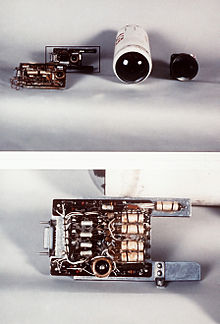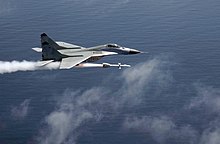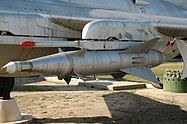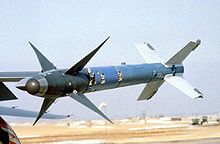Air-to-air missile
An air-to-air missile is a (usually) guided missile that is used as a weapon in aerial combat . The name says that it is fired in the air to hit targets in the air.
Internationally, the English term Air-to-Air Missile ( AAM ) or Air-launched (A) Intercept-aerial (I) Guided Missile (M) ( AIM ) is often used.
Corresponding counterparts are surface-to-air missiles and air-to-surface missiles , whereby the ground also includes ships.
history
First World War
During the First World War , the Allied air forces used small unguided Le Prieur rockets carried by biplanes to defend against German airships . The conventional aircraft armament with small-caliber machine guns was relatively ineffective compared to the zeppelins. However, Le Prieur missiles were very inaccurate and had a short range. When improved guns and ammunition became available, they were no longer used.
In order to increase the dangerously short distance when using machine guns to shoot enemy aircraft by only 20 to 30 meters, Rudolf Nebel himself manufactured air-to-air missiles on the French front in 1917. In the summer of 1917 Nebel shot four self-made air-to-air missiles from his fighter plane into a British aircraft formation from a distance of about 100 meters (Rudolf Nebel: "An incredible distance for the conditions at the time"). It did not hit, but the pilot of an English biplane panicked over the incident, landed immediately and became a German prisoner of war. Eight days later, Nebel achieved the first kill of an enemy aircraft. One of his air-to-air missiles smashed the propeller of the machine, which then crashed on the ground.
A week later, on the next mission, two of the four rockets exploded when fired on his aircraft, an Albatros D III. Nebel managed to make an emergency landing in which the machine overturned and he suffered burns. After his return from the hospital, he was awarded the Iron Cross First Class for the two aerial victories with his air-to-air missiles , and at the ceremony that followed, Nebel's aviator Hermann Göring suggested that the new weapon be called Nebelwerfer . That same evening, Nebel was forbidden to continue using the weapon as too dangerous for its own pilots, and new weapons were a matter for the inspection of the air force in Berlin. Three weeks later, Nebel was called to Berlin by the inspector of the air force, Colonel Siebert, to explain his invention to him and a pyrotechnician. No other result of Nebel's air-to-air missiles on the German side in World War I is known.
Second World War
During the Japanese-Soviet border conflict shortly before the Second World War, some Soviet Polikarpov I-16 pilots flew with unguided "RS" missiles attached to four launch rails on each wing side in addition to machine gun armament. This was the first time that a Japanese Nakajima Ki-27 aircraft was shot down on August 20, 1939 .
At the beginning of the Second World War , the Reich Aviation Ministry awarded various development contracts for guided air-to-air missiles. After the use of rather primitive weapons, work began in 1943 on the Henschel Hs 117 H, which was based on a surface-to-air missile . At almost the same time, the Ruhrstahl X-4 was developed, which performed better. Both developments came too late to be used in combat.
The only air-to-air missile used by the German side in World War II was the unguided R4 / M "Orkan" . 12,000 of them were produced by the end of the war.
The early air-to-air missiles up to the end of World War II were unguided missiles that were fired in volleys. In the 1950s and 1960s, the unguided missiles were supplemented by guided air-to-air missiles with newly developed infrared or radar search heads and finally replaced.
Classification
In the western world, air-to-air missiles are known almost exclusively by their English names. The reasons for this lie in the pioneering role of the USA and the NATO membership of the other western countries. Air-to-air missiles are classified according to their operational range.
Short and medium haul
- Visual Range Air-to-Air Missile (VRAAM)
Field-of-vision air-to-air missile - this internationally used English term describes guided missiles for targets to be attacked at visual range (mostly with infrared guidance). A distinction is made here between:
- Short Range Air-to-Air Missile (SRAAM)
Short-range air-to-air missile - for short to very short distances, or
- Within-Visual-Range Air-to-Air Missile (WVRAAM)
Field-of-view air-to-air missile - common at medium ranges.
- Advanced Short-Range Air-to-Air Missile (ASRAAM)
Improved Short Range Air-to-Air Missile - is an advanced / improved short-range air-to-air missile.
- Advanced Medium-Range Air-to-Air Missile (AMRAAM)
Improved medium-range air-to-air missile - is an advanced / improved medium-range air-to-air missile.
Long haul
- Beyond Visual Range Air-to-Air Missile (BVRAAM)
Out of View Air-to-Air Missile - is a missile that has a range beyond the horizon. It is able to fight targets that are out of the pilot's range of vision. Almost without exception with radar steering.
construction
The basic structure of an air-to-air missile consists of a seeker head with a steering system , the warhead and the drive unit .
Seeker head

For the pilot, it is important to distinguish between steering bodies with further guidance after firing and those that do not require any further attention from the pilot or the weapons control computer of the firing aircraft (so-called fire-and-forget guided weapons). A seeker head consists of one or more sensors (seekers) , usually in the tip of the rocket, the control (either VPS or PLC ), which converts the sensor information into control commands, and the control surfaces , with which the flight direction of the rocket is influenced.
Four different types of seekers are used, each with a different mission profile:
- Imaging
- This is a passive search method in which an imaging sensor ( focal plane array mostly CCD or CMOS ) reacts optically (visible light ) or quasi-optically ( UV / infrared ) to the electromagnetic emissions of the target. Newer seeker heads are multispectral in order to increase the interference immunity. Imaging viewfinders are mostly used in short-range missiles because their sensitivity and response threshold and thus their range are limited.
- Semi-active radar
- A semi-active target search method in which the target is illuminated by a radar system that is independent of the rocket and the seeker head of the rocket follows the radar radiation reflected from the surface of the target. Since the radar of the firing aircraft is mostly used for target illumination, which forces it to remain in the combat zone and enormously increases its vulnerability , semi-active seekers in newer missile types are increasingly being replaced by active ones. A special form is the so-called beam riding , in which the rocket directly follows the lobe of the radar. The receiver is in the rear of the rocket. This method guarantees high resistance to interference, but has the same disadvantages as the normal semi-active control
- Active radar
- An active seeker with the radar transmitter and receiver in the missile.
- Passive radar
- A passive seeker in which the missile takes aim at the emission sources of the target aircraft.
In modern air-to-air missiles, several seekers are often combined in one seeker head in order to increase interference immunity and reduce the advance warning time for the enemy. Medium- and long-range missiles also have inertial navigation systems or satellite navigation , which make it possible to cover large parts of the flight route to the target without emissions and with high resistance to electronic countermeasures by the enemy. The active seeker is only activated in the immediate vicinity of the enemy. In this way, passive imaging seekers can also be used in long-range missiles.
Almost all air-to-air missiles have some form of data link to the take-off aircraft, at least simplex as an emergency stop switch, but sometimes also duplex, in order to perform a target assignment after the weapon has been launched ( lock-on after launch , LOAL) or to change it.
Warhead
The warhead consists of one or more detonators and an explosive charge . Either proximity or impact detonators are used as detonators .
Missiles with an impact fuse usually contain smaller amounts of explosives and are therefore lighter. To do this, they must have high-quality route guidance systems. The damage then occurs through puncturing the target and punctual destruction.
Most air-to-air missiles use proximity fuze and explosive fragmentation or continuous rod charges. Blasting fragmentation charges consist of explosives enclosed in fragmented metal shells, so that after the explosion, fragmentation clouds are formed. The continuous rod charge consists of a metal ring folded around an explosive charge, which is unfolded in a flash by the explosion of the explosive and cuts through targets within its diameter.
Today only conventional warheads are used. During the Cold War , the United States had the AIR-2 Genie unguided air-to-air missile with a 1.5 kT nuclear warhead and the AIM-26 Falcon guided air-to-air missile with a 0.25 kT nuclear warhead - Warhead. Both weapons were intended for the destruction of Soviet bomber groups.
drive
Most air-to-air missiles are propelled by a rocket engine. The speeds achieved are between Mach 2 and Mach 5 , depending on the type of drive, weight and intended use (short, medium or long-range weapon) . One characteristic of newer drives is the low level of smoke generated during combustion. This makes it more difficult for the pilot and the sensors of the targeted aircraft to recognize the missile in good time and to initiate countermeasures. The following types of drive are used:
- Solid rocket engine
- The advantages of solid matter lie in the ease of handling (storage, assembly) and the thrust of the fuel, the disadvantage in the poor controllability of the thrust , since once the fuel reaction has started it can no longer be throttled or even stopped. Solid rocket engines are used in air-to-air guided missiles of all ranges. A recent development in the field of solid propulsion is double pulse motors. The combustion chamber is segmented into a front and a rear part with a partition. During the combustion of the first pulse propellant, the second pulse propellant is protected from the hot gases and thus from premature ignition by a separating device. When the front combustion chamber is ignited, the partition bursts; if only the rear one is ignited, it remains intact. The two parts can thus be ignited either one after the other with an arbitrarily selectable time interval or simultaneously in order to increase the range and hit rate. A major advantage of this drive design is that the missile behaves aerodynamically identically during the function of the first and second pulse propellants. Solid rocket engines are used in most air-to-air missiles.
- Liquid rocket engine
- Liquid rocket engines were mainly used in the early days of the development of air-to-air missiles, when solid propulsion systems were not yet available. They have the advantage of better controllability and the disadvantage of a more complex structure. The fuels used can also corrode the engine. This technique is no longer used today. The Ruhrstahl X-4 is a historical example .
- Ramjet
- Ramjets are air-breathing jet engines that only work at supersonic speeds. Therefore, an additional booster is required to start. The advantage is the higher degree of efficiency , which means lower fuel consumption in contrast to solid fuel rockets, which allows a greater range or a lighter drive. There is also no need to carry an oxidizing agent . A ramjet engine is used, for example, in the MBDA Meteor and an improved version of the Russian R-77 .
application
begin

For air-to-air guided missiles, the maximum range is often specified. The effective range of a weapon, however, depends on factors such as altitude and speed of the launch platform as well as the position and direction of flight of the target. The AA-12 Adder / R-77 has a range of ~ 100 km. This information relates to a target at high altitude that flies head-on towards the firing fighter aircraft and remains without warning until the final approach ( term : endgame) and maintains its course. At low altitudes and when the target is fought from behind, the effective range is reduced by 75 to 80% to 20 to 25 km. If the target is warned in advance and it flies evasive maneuvers, the range is reduced again. The following performance parameters determine the effectiveness of an air-to-air missile:
- A pole
- Distance from the launch platform to the target when the missile activates its viewfinder and locks the target itself
- F pole
- Distance from the launch platform to the target when the missile arrives at the target
- Launch Success Zone
- Target area in which the missile has a high hit rate if the target has not been warned
- No-Escape Zone
- Target area in which the missile has a high hit rate, even if the target has been warned and takes countermeasures such as flares , chaffs and evasive maneuvers
- All-Aspect
- The missile can lock on a target from any angle and not only from behind (only relevant for infrared-guided weapons).
- Off-boresight
- Describes the ability to capture targets off the longitudinal axis, i.e. the pan angle of the viewfinder
- Tracking rate
- The speed at which the seeker head can move
Depending on the parameters mentioned above and the chosen tactics, the missile is then fired. For example, if a transport aircraft has to be escorted, it makes sense to fire the weapon at the maximum distance of the Launch Success Zone . If the attacked person changes course and turns around, the guided missile misses the target aircraft, but the opponent's attack on the transport aircraft is prevented or made more difficult. In dogfights with many opponents, it makes sense to only fire the missile at the enemy when the enemy is within the no-escape zone .
In the case of weapons of medium and long range, the guided missile is usually sent the current position and course of the target from the carrier platform when it takes off. The navigation during the flight phase then takes place with an inertial navigation system and a data link to the launch platform. This data link enables the launch platform's radar to continuously supply the weapon’s guidance system with new target data so that it can optimize the missile's trajectory in order to achieve the highest possible detection probability when the guided missile activates its viewfinder in the target area. This is particularly important for missiles with a long range, since the inertial navigation system becomes more and more imprecise with increasing distance and the target has more time to change its course and thus prevent detection by the weapon itself. However, the carrier platform must turn to the missile in order to be able to send the data, so that the advantage of the higher precision cannot be used effectively in some combat situations; the data link can also be disrupted by opposing electronic countermeasures .
The following NATO code words are used when using weapons:
- Fox One
- Launch of a guided missile with a semi-active radar seeker head (example: AIM-7 Sparrow )
- Fox Two
- Launch of a guided missile with infrared seeker head (example: AIM-9 Sidewinder )
- Fox Three
- Launch of a guided missile with active radar seeker head (example: AIM-120 AMRAAM )
- Broke lock
- Loss of seeker contact with target when the weapon is still attached to the starter, usually in dogfights with short-range weapons
- Locked
- The target was activated with on-board radar
- Pit bull
- Guided missile has activated the target with its own radar, only possible with weapons with active radar seeker, comes after Fox Three
- Maddog
- Missile has switched the target already from the start of track with its own radar, will then take Fox Three used
Countermeasures

The first step in taking countermeasures is recognizing that a missile has been fired at your aircraft. This is followed by the determination of the direction and the distance as well as a classification of the rocket in infrared (IR) or radar controlled. The pilot of a modern combat aircraft is supported by the on-board computer, which also coordinates the aircraft's electronic countermeasures .
Depending on the classification of the steering body, the pilot initiates the first countermeasures by ejecting decoys. For IR missiles, these are so-called flares , small magnesium flares that show strong heat development and are intended to deflect the seeker head of the missile or to cover up the heat radiation from the aircraft.
Radar-guided missiles are fooled by the dropping of chaff , which form small clouds of pieces of metal foil. These clouds reflect the radar radiation of the seeker head (or the attacking aircraft) better than the attacked aircraft and are easier victims.
However, modern air-guided weapons are able to identify such decoys after a short time and can thus only be distracted for a short time. The challenge for the attacked pilot is therefore to combine countermeasures with other methods, for example with evasive maneuvers. The advantage of the rocket is also its disadvantage: its speed. Because it is up to twice the speed of the attacked aircraft, it will lose the target from the search area if it has been outmaneuvered. In contrast to the attacked aircraft, the maneuverability of the guided missile is not restricted by the G-tolerance of humans. While the maneuvers of this are limited to 9 g , 9 times the acceleration due to gravity , before the g- LOC occurs, air-to-air missiles can withstand up to 70 g . The force is linearly dependent on the mass, quadratically on the speed of the missile and inversely proportional to the radius of the flown curve.
If the attacked pilot forces the missile into a tight curve, the guided missile can reach its tolerance limit and no longer follow the movement of the aircraft. The turning radius becomes smaller and more unfavorable for the rocket the closer it comes to the aircraft. Timing is therefore an essential factor in countermeasures.
A classic evasive maneuver is the barrel roll . Here, the aircraft moves on a circular path around the longitudinal axis, the underside of the aircraft always pointing outwards. The superposed movement results in a spiral path. If this movement is combined with a main direction of movement tapering towards the missile at an acute angle, the missile control computer is faced with a difficult task.
List of air-to-air guided missiles
ks = short distance; ms = middle distance; ls = long distance;
 United States
United States
Current models:
Historical models:
- AIM-4 Falcon ks
- AIM-7 Sparrow ms
- AIM-26 Falcon
- AIM-47 Falcon
- AIM-54 Phoenix ls
- AIM-68 Big Q ks
- AIM-82 ks
- AIM-95 Agile ks
- AIM-97 Seekbat ls
- AIM-152 AAAM
- AIR-2 genius ks
 European Union
European Union
Current models:
- BGT IRIS-T ks
- MBDA Meteor ms
- BAe AIM-132 ASRAAM ks
- BAe Skyflash ms
- MBDA MICA ms
- Alenia Aspide ms
- Matra R.550 Magic and Magic II ks
Historical models:
- Fairey Firestreak ks
- Matra R.530 ks
- Matra Super 530 ms
- Hawker Siddeley Red Top ks
- Red Dean ks
- Saab 372
- Saab 373
 Russia
Russia
Current models:
- R-73 (AA-11 Archer ) ks
- R-60 (AA-8 Aphid ) ks
- R-27 (AA-10 Alamo ) ms
- R-77 (AA-12 adder ) ms
- R-33 (AA-9 Amos ) ls
- R-37 (AA-13 Arrow ) ls
- Novator KS-172 AAM-L ls
Historical models:
- Kaliningrad K-5 (AA-1 alkali ) ks
- R-3 (AA-2 Atoll ) ks
- Kaliningrad K-8 (AA-3 Anab ) ms
- Raduga K-9 (AA-4 Awl ) ls
- Bisnowat R-4 (AA-5 Ash ) ls
- Wympel R-40 (AA-6 Acrid ) ks
- R-23/24 (AA-7 Apex ) ks
 People's Republic of China
People's Republic of China
Current models:
Historical models:
 Israel
Israel
Current models:
Historical models:
 South Africa
South Africa
Current models:
- Kentron V3 ks
- Denel LRAAM (S-Darter) ls
Historical models:
- Kentron V1 ks
- Kentron V2 ks
- Kentron V4 R-Darter ls
Other states
- Tien Chien ( Sky Sword I ; Taiwan ) ks
- Tien Chien II ( Sky Sword II ; Taiwan ) ms
- AAM-3 ( Japan ) ks
- AAM-5 ( Japan ) ks
- AAM-4 ( Japan ) ms
- MAA-1 Piranha ( Brazil ) ks
- Fatter ( Iran ) ks
Individual evidence
- ^ Rudolf Nebel: The fools of Tegel. Droste Verlag, Düsseldorf 1972, ISBN 3-7700-0314-4 , pp. 36-39.
literature
- Jeremy Flack: NATO Air Forces guided and dropped weapons. Motorbuch Verlag, ISBN 3-613-02525-6 .



